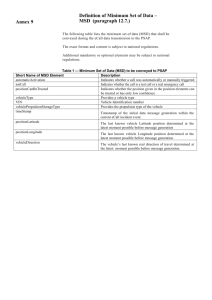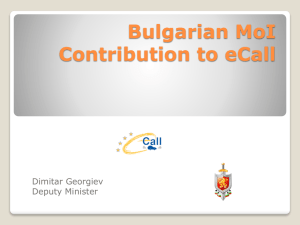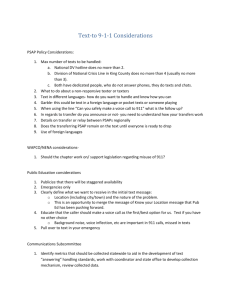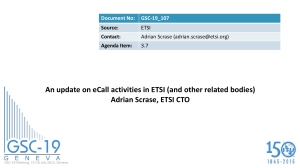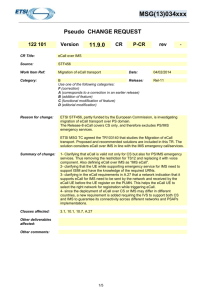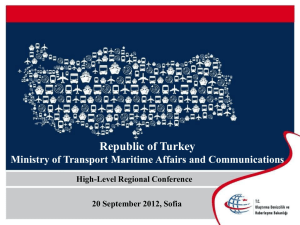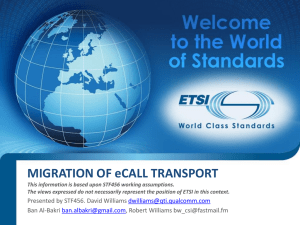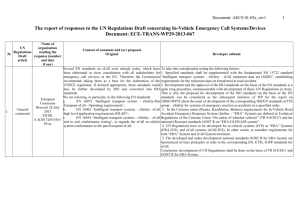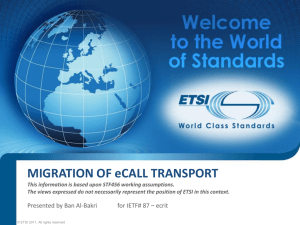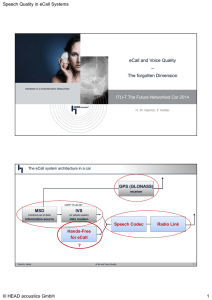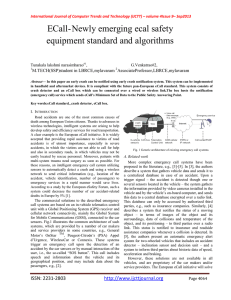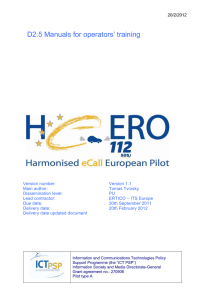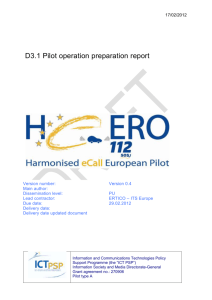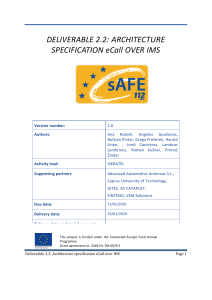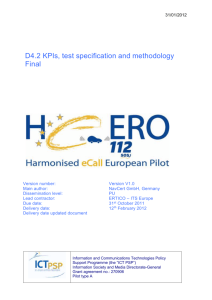pseudo_CR-123 167-r2
advertisement
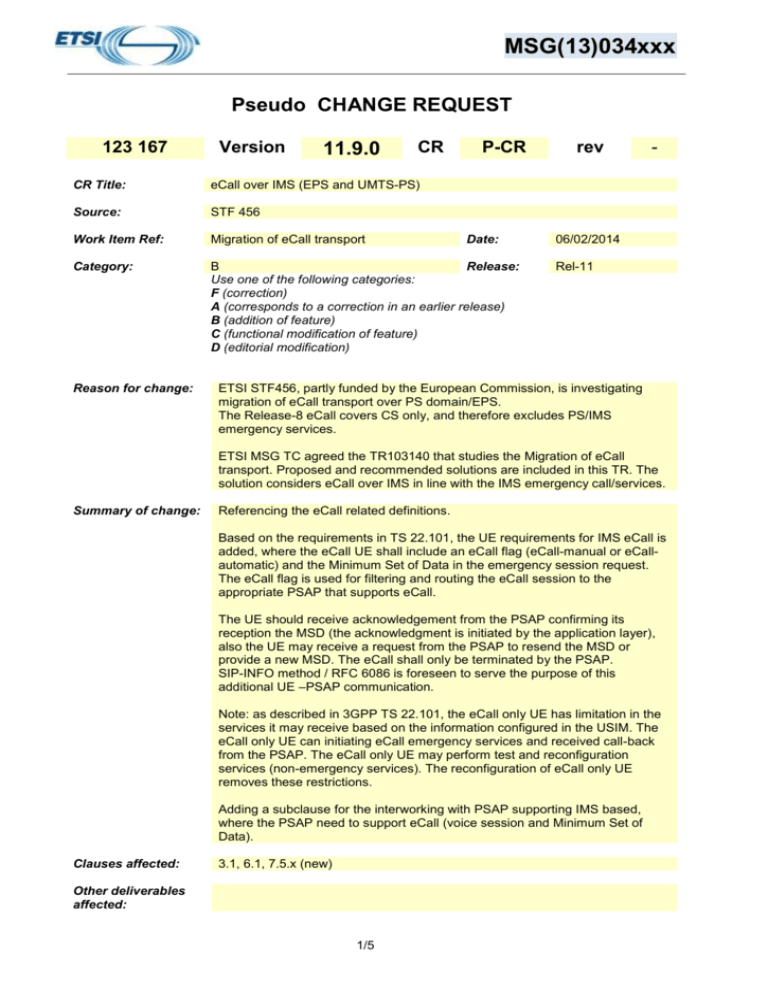
MSG(13)034xxx Pseudo CHANGE REQUEST 123 167 Version 11.9.0 CR P-CR CR Title: eCall over IMS (EPS and UMTS-PS) Source: STF 456 Work Item Ref: Migration of eCall transport Category: B Release: Use one of the following categories: F (correction) A (corresponds to a correction in an earlier release) B (addition of feature) C (functional modification of feature) D (editorial modification) Reason for change: Date: rev - 06/02/2014 Rel-11 ETSI STF456, partly funded by the European Commission, is investigating migration of eCall transport over PS domain/EPS. The Release-8 eCall covers CS only, and therefore excludes PS/IMS emergency services. ETSI MSG TC agreed the TR103140 that studies the Migration of eCall transport. Proposed and recommended solutions are included in this TR. The solution considers eCall over IMS in line with the IMS emergency call/services. Summary of change: Referencing the eCall related definitions. Based on the requirements in TS 22.101, the UE requirements for IMS eCall is added, where the eCall UE shall include an eCall flag (eCall-manual or eCallautomatic) and the Minimum Set of Data in the emergency session request. The eCall flag is used for filtering and routing the eCall session to the appropriate PSAP that supports eCall. The UE should receive acknowledgement from the PSAP confirming its reception the MSD (the acknowledgment is initiated by the application layer), also the UE may receive a request from the PSAP to resend the MSD or provide a new MSD. The eCall shall only be terminated by the PSAP. SIP-INFO method / RFC 6086 is foreseen to serve the purpose of this additional UE –PSAP communication. Note: as described in 3GPP TS 22.101, the eCall only UE has limitation in the services it may receive based on the information configured in the USIM. The eCall only UE can initiating eCall emergency services and received call-back from the PSAP. The eCall only UE may perform test and reconfiguration services (non-emergency services). The reconfiguration of eCall only UE removes these restrictions. Adding a subclause for the interworking with PSAP supporting IMS based, where the PSAP need to support eCall (voice session and Minimum Set of Data). Clauses affected: 3.1, 6.1, 7.5.x (new) Other deliverables affected: 1/5 MSG(13)034xxx Other comments: 2/5 MSG(13)034xxx 3.1 Definitions For the purposes of the present document, the terms and definitions given in TR 21.905 [11] and the following apply. A term defined in the present document takes precedence over the definition of the same term, if any, in TR 21.905 [11]. Charging Data Record: Record generated by a network element for the purpose of billing a subscriber for the provided service. See TS 32.260 [35] for further details. Connectivity Session Location and Repository Function (CLF): As per ETSI ES 282 004 [18], the Connectivity Session Location and Repository Function (CLF) registers the association between the IP address allocated to the UE and related network location information, i.e.: access transport equipment characteristics, line identifier (Logical Access ID), IP Edge identity. Emergency Call Server (ECS): The functional entity consists of a Location Retrieval Function (LRF) and either a routing proxy or a redirect server, e.g. an ECS contains a VPC and a Routing Proxy or Redirect Server in NENA I2 architecture [17]. Emergency-CSCF: The Emergency-CSCF handles certain aspects of emergency sessions, e.g. routing of emergency requests to the correct emergency centre or PSAP. Emergency Service Query Key (ESQK): A 10-digit North American Numbering Plan number used to identify a particular emergency call instance. It is used by the LRF as a key to look up for the location information and callback information associated with the emergency call instance and is also used by the PSAP to query location information from the LRF. Emergency Service Routing Key (ESRK): see TS 23.271 [5] or J-STD-036 [23]. Emergency Service Routing Number (ESRN): North American Numbering Plan number used for routing of an emergency call to the appropriate gateway for an eventual delivery towards a CS-based PSAP. Geographical Location Information: Location indicated in geographical terms, for example geographical coordinates or street address (e.g. as supported by IETF RFC 4119 [14]). Local regulation: Condition defined by the authority whose legislation applies where the emergency service is invoked. Location Identifier: Information about the current location of the UE in the network. Location is indicated in network terms, for example using the global cell id in cellular networks, line-id in fixed broadband networks, (OMA-Location also uses this term, but OMA so far defines the Location Identifier only for cellular access.) Location Information: The location information may consist of the Location Identifier, and/or the Geographical location information. Location Retrieval Function (LRF): This functional entity handles the retrieval of location information for the UE including, where required, interim location information, initial location information and updated location information. The LRF may interact with a separate RDF or contain an integrated RDF in order to obtain routing information. The LRF may interact with a separate Location Server or contain an integrated Location Server in order to obtain location information. The LRF may interact with or contain other types of location server functions in order to obtain location information. Location Server (LS): General term for the entity responsible for obtaining the location of the UE (e.g. GMLC see 3GPP TS 23.271 [5], MPC see 3GPP2 X.S0002 [24] or SLP see OMA AD SUPL [15]). Last Routing Option (LRO): A number, which may be used in the event of network failure towards a specific location based PSAP or a number that can be associated to a national or default PSAP/Emergency centre. Operator policy: Condition set by operator. Private Numbering Plan: According to ETSI TS 181 019 [36], a numbering plan explicitly relating to a particular private numbering domain. Public Safety Answering Point (PSAP): A physical location, where emergency calls from the public are received. 3/5 MSG(13)034xxx Routing Determination Function (RDF): The functional entity, which may be integrated in a Location Server or in an LRF, provides the proper PSAP destination address to the E-CSCF for routing the emergency request. It can interact with a LS to manage ESQK allocation and management, and deliver location information to the PSAP. For the purposes of the present document, the following terms and definitions given in TS 24.229 [19] apply: Private Network Traffic NOTE: All traffic from UEs having registered a contact bound to a public user identity receiving hosted enterprise services, is private network traffic. Public Network Traffic For the purposes of the present document, the following terms and definitions given in TS 22.101 [13] apply: eCall eCall only UE Minimum Set of Data (MSD) ********************************** Next Change ******************************* 6.1 UE - Should be able to detect an emergency session establishment request. - Initiate an IMS emergency registration request. - The UE may perform an IMS emergency session establishment without prior emergency registration when already IMS registered and it is in home network (e.g. including IP-CANs where roaming outside the home network is not supported). - Otherwise, the UE shall perform an IMS emergency registration. - Include an emergency service indication in the emergency session request. - Include an equipment identifier in the request to establish an emergency session for "anonymous user". NOTE 1: "Anonymous user" in this context is the person who does not have sufficient credential for IMS registration. No Stage 3 work is expected as the anonymous user detection already existed today. - Include identity information for the IP-CAN if available (e.g. MCC-MNC or an equivalent) NOTE 2: UE provided IP-CAN identity information will not be completely reliable. - a UE performing eCall, determined by information configured in the USIM, shall include an eCall flag, (eCallmanual or eCall-automatic) that is used for filtering and routing eCall to the appropriate PSAP, and the MSD in the emergency session request. The UE should receive acknowledgement from the PSAP confirming its reception of the MSD, also the UE may receive a request from the PSAP to provide a new MSD. The eCall shall only be terminated by the PSAP. See 3GPP TS 22.101 [8]. - Attempt the emergency call in CS domain, if capable. - Handle a 380 (Alternative Service) response with the type set to "emergency" e.g. as a result of non UE detectable emergency attempt. - Handle a response with an indication, IMS emergency registration required as a result of emergency session establishment attempt. - Other general requirements of UE shall be referred to the general requirements of emergency calls in TS 22.101 [8]. The UE initiates the emergency session establishment request, and for the purpose of processing the request properly in the network the following specific information is supplied in the request message. 4/5 MSG(13)034xxx - Emergency session indication. - A registered Public User Identifier. If the UE performed an emergency registration using a temporary Public User Identifier then the UE should not use the temporary Public User Identifier to initiate the emergency session. The selected Public User Identifier shall be part of an implicit registration set that includes a TEL-URI. NOTE 3: The UE can be preconfigured with information to select the appropriate Public User Identifier if more than one Public User Identifier is provisioned in the UE. - Optionally, type of emergency service. It could be implied in the above emergency session indication. - UE's location information, if available. - The TEL-URI associated to the Public User Identifier, if available. - GRUU, if available. In the case of a non UE detectable emergency call, upon reception of indication from the network, the UE shall handle the call as described in clause 7.1.2. NOTE 4: If the indication was received in a rejection message the UE performs appropriate emergency error handling procedures. ********************************** Next Change ******************************* 7.5.x PSAP/Emergency centre supporting IMS based eCall A PSAP connected via IP and supports eCall voice and Minimum set of data (MSD) as specified in TS 22.101 [8]. No special procedures are identified in IMS Core. The PSAP uses the public user identity that it has received from the user for call back. Emergency call and call back feature interactions are handled as specified in TS 22.101 [8]. Editor’s Note: if the eCall PSAP is CS based then protocol conversion is required, however using CS eCall (in-band modem) end-to-end is the preferred solution in this case – see ETSI TR103140. 5/5
